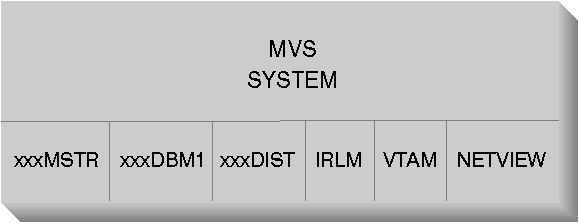Connectivity Supplement
Figure 1 shows an MVS system running a single copy of DB2 for
MVS/ESA. It is also possible to run multiple copies of DB2 for MVS/ESA
on a single MVS system. To identify copies of DB2 for MVS/ESA within a
given MVS system (or copies of DB2 for MVS/ESA within an MVS/JES complex),
each DB2 system is given a subsystem name, a one- to four-
character string unique within an MVS/JES complex. In Figure 1, the DB2 for MVS/ESA subsystem name is xxxx.
Three of the MVS address space names are prefixed by the DB2 for MVS/ESA
subsystem name. These three address spaces make up the DB2 for MVS/ESA
product.
Figure 1. MVS Address Spaces used by DB2 for MVS/ESA
Figure 1 shows the MVS address spaces involved in distributed
database processing with DB2 for MVS/ESA. These address spaces work
together to allow DB2 for MVS/ESA users to access local relational databases
and communicate with remote DRDA systems. The purpose of each address
space is as follows:
- xxxxMSTR
- The system services address space for the DB2 for MVS/ESA product
responsible for starting and stopping DB2 for MVS/ESA, and controlling local
access to DB2 for MVS/ESA.
- xxxxDBM1
- The database services address space responsible for accessing relational
databases controlled by DB2 for MVS/ESA. This is where the input and
output to database resources is performed on behalf of SQL application
programs.
- xxxxDIST
- The portion of DB2 for MVS/ESA that provides distributed database
capabilities; also known as the Distributed Data Facility
(DDF). When a distributed database request is received, DDF
passes the request to xxxxDBM1, so that the required database I/O
operations can be performed. This book describes DDF in detail.
- IRLM
- The lock manager used by DB2 for MVS/ESA to control access to database
resources.
- VTAM
- The SNA Communications Manager for the MVS system. DDF uses VTAM to
perform distributed database communications on behalf of DB2 for
MVS/ESA.
- NETVIEW
- The network management focal point product on MVS systems. When
errors occur during distributed database processing, DDF records error
information (also known as alerts) in the NetView hardware monitor
database. System administrators can use NetView to examine the errors
stored in the hardware monitor database, or provide automated command
procedures to be invoked when alert conditions are recorded.
NetView can also be used to diagnose VTAM communication errors. For
more information, see the Distributed Relational Database Architecture
Problem Determination Guide.
Figure 1 does not show any SQL application programs. When an
application program uses DB2 to issue SQL statements, the application program
must attach to the DB2 for MVS/ESA product in one of the following ways:
- TSO
- Batch jobs and end users logged on to TSO are connected to DB2 for MVS/ESA
through the TSO attach facility. This is the technique used to connect
SPUFI and most QMF applications to DB2 for MVS/ESA.
- CICS/ESA
- When a CICS/ESA application issues SQL calls, the CICS/ESA product uses
the CICS attach interface to route SQL requests to DB2 for MVS/ESA.
- IMS/ESA
- Transactions running under the control of IMS/ESA use the IMS attach
interface to pass SQL statements to DB2 for MVS/ESA for processing.
- DDF
- The Distributed Data Facility is responsible for connecting distributed
applications to DB2 for MVS/ESA.
- CAF
- The call attachment facility allows user-written subsystems to connect
directly to DB2 for MVS/ESA.
[ Top of Page | Previous Page | Next Page ]
